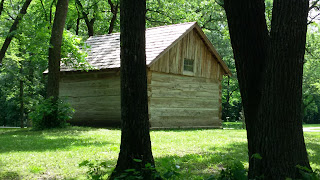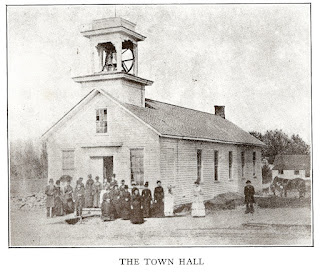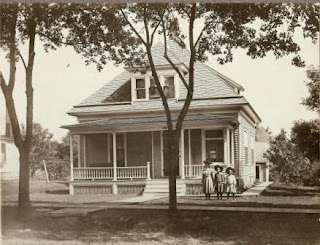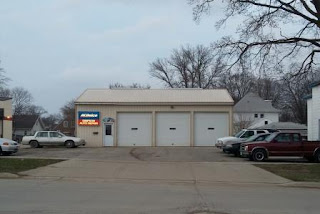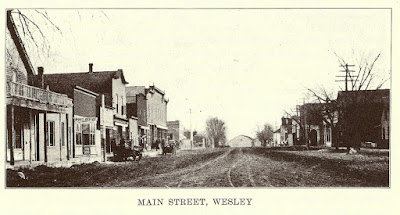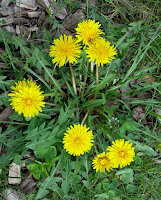It was 160 years ago this month that John and Elizabeth Heckart and their family came to Algona. They had come to join the community founded by their daughter, Sarah Heckart Call, and her husband, Asa. Another daughter, Emma, arrived with them.
First published in the Upper Des Moines Republican on December 13, 1911, the intriguing story below was handwritten by Emma Heckart at the request of Benjamin Reed, then serving as president of the Kossuth County Historical Society. Portions of the story were used by Mr. Reed in his History of Kossuth County published in 1913, but her memories are worth reading in their entirety.
First published in the Upper Des Moines Republican on December 13, 1911, the intriguing story below was handwritten by Emma Heckart at the request of Benjamin Reed, then serving as president of the Kossuth County Historical Society. Portions of the story were used by Mr. Reed in his History of Kossuth County published in 1913, but her memories are worth reading in their entirety.
REMEMBRANCE OF
EARLY ALGONA
By: Miss Emma Heckart
In my far away
home in Florida comes a request from the president of the Kossuth County
Historical Society for a paper on the early history of Algona. The story has often been told by abler pens
than mine, but as it is ever a pleasure to recall those days, I will, at the
risk of being tiresome, tell again the little that I know.
ARRIVAL
It was on the
10th of May, 1856, that we pulled into Algona. We had made a five hundred mile trip from
Elkhart, Indiana, with a four-ox team, in just seven weeks’ time. I was but a child then, eleven years old, and
can with certainty recall but little of the order in which the settlers moved
in and built their houses, but the first glimpse I had of the place is firmly
fixed in my memory.
The log house
on our left, which could be plainly seen with the naked eye, was known as the
“Joe Moore cabin” and a right hospitable place it must have been, for inside
could be seen Jerome Stacy, W. H. Ingham, L. H. Smith, Abe Hill, Jake Cummins,
Father Taylor, the Joe Thompson family, and I don’t know how many more.
There were
eight of us—my father and mother, Michael Fisher, my mother’s brother, who died
the following winter and was the first settler buried in Riverview Cemetery, a
teamster, who had come with us from Indiana, a sister, two brothers and myself,
and I have no doubt but that we too could have found shelter under the same
roof if we had applied for admission, but we were aiming for another
point. Straight to the northwest we
steered our craft, over cementless walks and houseless lots and soon came in
sight of another cabin—the home of my sister, Mrs. Call, who had preceded us by
nearly two years, and whom we were all anxious to see. Love is stronger than gold or lands and it
was more through her letters of entreaty that “we come to Algona and live near
her” than the lure of Uncle Sam’s broad prairies that had urged us on through
spring rains, mud and slush and treacherous sloughs and was even now bringing
us to her cabin door.
The oxen were
too slow for me and jumping out while the wagon was visibly moving, I rushed
for the cabin door into the middle of the room, but no Sarah could be
seen. Standing there and wondering where
she could be I heard a suspicious little sniffle behind the door. Looking back I found my sister, overcome with
joy at meeting all again, she had hidden herself and was crying and laughing
simultaneously.
Many and long
have the years been, dear sister since we mingled our tears behind your cabin
door, but they will be fewer and shorter till we meet again at heaven’s open
portal.
I had two other
sisters then but neither one quite so dear as Sarah. She had nursed me in my infancy, played with
me in childhood, and taught me to read, knit and sew. She was at once mother, sister, playmate and
friend. Sacred to me is her memory.
A few rods east
of the Call cabin, showing through the trees and hazel thicket, stood the four
walls of our own. Kind neighbors had,
before we arrived, raised the building and cut openings for one door and half a
window. We stayed with the Calls one
week till our cabin was finished and then took possession. We had a fine garden that year—everything
seemed to thrive on the rich Iowa soil and father and mother and brother Cal
raised an abundance of seed-corn, potatoes and watermelons.
INDIAN SCARES
One day after we had been living in our new home for about a week, a tent was pitched a few rods east of our cabin. Like a big mushroom it had sprung up in a few hours. Men and boys, women and girls, dogs and horses were moving in lively commotion. Hezekiah Henderson had come to town, and judging by the goods he had brought with him, had come to stay. I don’t remember the length of time they lived in this tent, but “Ki” was an energetic man and before the terrible winter of “56-7 had set in he had built a commodious hewn log cabin near the present site of the Thorington Hotel and had his numerous family warmly housed. It was the largest cabin in town and was a much needed place, for here the homeless young men who were seeking their fortunes in primitive Algona, found a good boarding place and travelers were hospitably entertained, and here one winter night the whole town rendezvoused for safety. It was in the winter of ’57, shortly after the massacre at Spirit Lake, we were aroused from our slumbers by a rap at the door, and someone in a fearfully low and blood-curdling voice told us to “get up quick, the Indians were just on the other side of the river, that they could see their camp fire with figures moving in front of it, that we must all go to Ki Hendersons.” It is needless to say we hurried. Excitement and fear prevented us making very great headway, but as fast as we were able sought refuge in the new cabin. The women and children were hustled off upstairs. Men with guns filled the room below, and others stood guard outside, with the understanding that if anyone fired off a gun without orders, he would be shot.
Fearfully we
waited, expecting any moment to hear the firing of guns and the whoop of
Indians, but not a sound was heard, nor a funeral note. We upstairs people grew tired listening and
waiting and one by one lopped over on to beds, chairs or floor and went to
sleep. When morning dawned we woke and
quietly went to our homes, thankful and surprised that we were still living.
That camp fire
with the figures moving in front of it was a singular vision. Captain Ingham and a few others with him
crossed the river that night to the north of the place where the light seemed
to be, but found no fire or Indians. And
I afterwards learned that people living on the West Branch of the Des Moines
river, twenty miles away, on the same night, saw the same light still west of
them as far as eye could see.
Another
comfortable and well built cabin was built in the summer of ’56 by Father
Taylor. Here he lived, and from here,
like the Master, who it was his delight to serve, went about doing good. He gave time, money and comfort for the
people among whom he had cast his lot.
Thus the log
cabin era of Algona was ended. It was
overlapped and in some instances reached far into the frame house period, but
these five cabins were all, I think, that was ever built on the town site. J. Ellison Blackford had built on the west
border of town in the summer of ’55, but it was over the line. Several young men and few newcomers had put
up log residences on their claims, but a steam saw mill, the boiler of which we
had passed fast stuck in a slough on our way here from near Independence, soon
supplied the people with a more easily manipulated building material, and time
has effectually covered the last traces of these early Algona homes.
The summer of
’56 was particularly prosperous and hopeful.
The crops were fine; the seed corn and potatoes yielded abundantly and
our garden was a surprise—a source of pleasure and profit.
Everything
seemed to thrive and everybody seemed pleased that they had come to
Algona. But if fortune’s pendulum swung
high it fell accordingly low during the winter that followed. Never since have we seen the snow so deep nor
the cold so intense. Thermometers often
registered 40 degrees below zero and snow as four feet deep on the level with
drifts twenty feet high. To keep warm
and get enough to eat were the mighty problems that faced us. Like the winter of 1620, when a few brave
pilgrims landed on the bleak shores of New England, “It was a time for trying
the stoutest hearts.” But the same
over-ruling Providence that preserved their lives was caring for us. A young man with a load of frozen pork, on his
way to Mankato, was stormbound in our town, and the people gladly bought his
whole load and considered it a Godsend.
I never heard what the people of Mankato thought about it.
The town would
soon have recovered from the gloom which that winter had cast over it, but
another blow was in store for it. The
Indian massacre at Spirit Lake effectually retarded all growth, and it was with
difficulty the few settlers then living here were induced to stay. A fortress was commenced but never
finished. After they had done their
terrible work at Spirit Lake the Indians left, never to return. A short time before we came to Algona they
had made their last visit to this place.
About one hundred of them had departed for new hunting grounds just
before we arrived, so that we have never had even a glimpse of the
savages. Before they left they assembled
on the knoll where the D. H. Hutchins house stands, and gathering a number of
pebbles, made a circle of them on the ground and marked each pebble with
red. We never could interpret the
meaning of the symbol.
A dead calm was
resting on the place; all immigration has ceased; building was suspended; the
saw mill was quiet. The ordinarily
routine of living went on. We raised our
crops that we might have something to eat, we ate that we might raise
more. Our churches and schools, lyceum and
social functions were faithfully attended.
We gradually grew accustomed to our quiet mode of living, always hoping
that the lull would, ere long, be broken.
But in ’61 a cloud came up from the South and for more than three years
its black hulk hung over us. Fort
Sumpter had been fired upon and quickly the discharge was felt in Iowa
homes. Civil War was upon us and some of
our number must go. Meetings were held
in the Town hall and speeches were made, firing the hearts of our young men
with enthusiasm. About twenty, I think,
left their homes and friends for the front—three came back. A few of them were killed in battle, but the
greater number died like rats in the trap.
Under orders of a half-drunken captain they were hurried off, as soon as
anyone showed any symptoms of being sick, to a poorly managed hospital, where
they promptly died after a few days treatment.
After the war
was ended and peace again settled over the land the thoughts of the people once
more turned westward and Algona received a fair share of the immigration. It has since increased steadily but rather
slowly in population and wealth till the present year, 1911, which is now
witnessing its most rapid growth since the summer of 1856.
I am afraid my
story is indeed tiresome, but when those old time memories are called up for
recognition they come trooping in such numbers and so rapidly it is difficult
to leave any unnoticed.
Emma
Heckart
Zephyr
Hills, Florida, Nov. 27, 1911
Mary Emmeline Heckart began teaching
school at the age of 17 making $20 per month.
She continued to teach for forty years.
Although she never married, she helped to raise two orphaned nieces,
Carrie Beall and May C. Walker. She made
her final home in Zephyr Hills, Florida, where she died on August 4, 1937.
Until
next time,
Jean,
a/k/a KC History Buff
If you enjoyed this
post, please don’t forget to “like” and SHARE to Facebook. Not a Facebook
user? Sign up with your email address in the box on the right to have
each post sent directly to you.
Be sure to visit the
KCHB Facebook page for more interesting info about the history of Kossuth
County, Iowa.
Reminder: The posts on Kossuth County
History Buff are ©2015-16 by Jean Kramer. Please use the FB “share”
feature instead of cutting/pasting.


